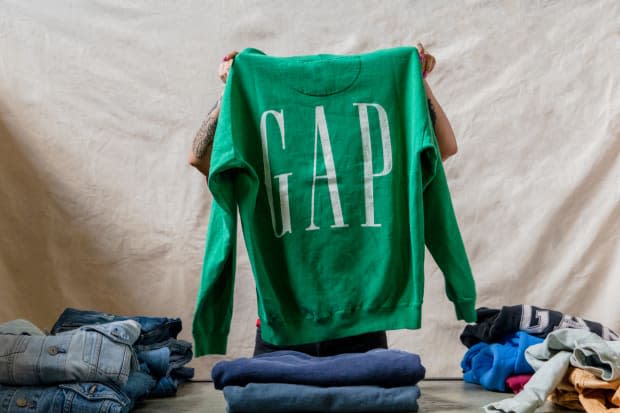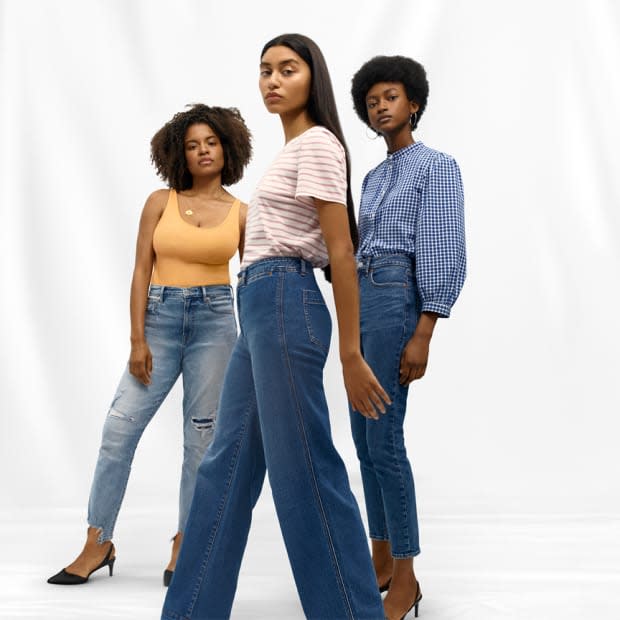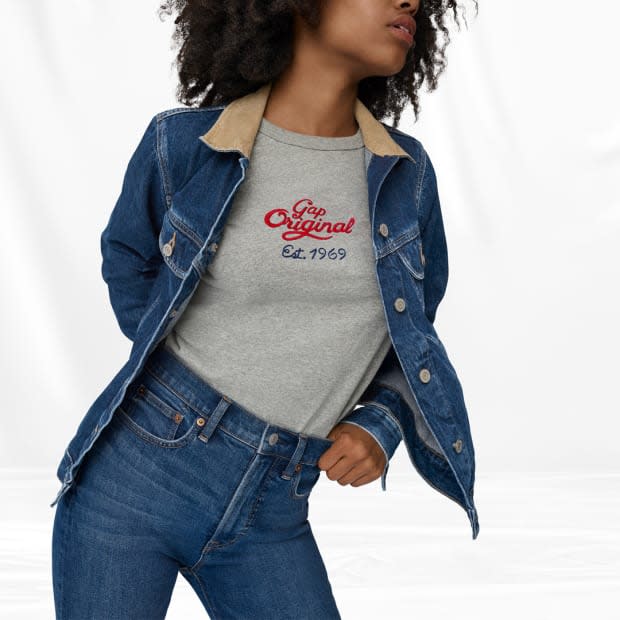To Find Relevance in Its 50th Year, Gap Looks to the Past
"The consumers love us, they just haven't seen us," says the brand's new CMO Alegra O'Hare.

On a hot day in late July, I traveled to a warehouse deep in Downtown Los Angeles to see what Atelier & Repairs, a local retailer that refurbishes vintage items — mostly workwear and denim — had done with an assortment of vintage Gap pieces from the '80s and '90s for a collaboration between the two parties. As I walked in and peeked at the racks, it was the first time in years I'd seen something with a Gap label that I thought was really, truly cool.
"This is going to look really fresh and really relevant because it's authentic," Atelier & Repairs founder Maurizio Donadi tells me matter-of-factly. "Modern brands are looking at brands from the '90s and '80s and Gap was very relevant at that time."
It's true. The high-waisted denim, some of which bore labels on the back I'd never even seen before; colorful, cozy sweatshirts and anoraks; and perfectly worn T-shirts served as reminders of Gap's rich history as a brand that was, at one time, very cool. While the collection is only in a few select stores, Gap hopes to create that same kind of reminder on a larger scale, and reignite the nostalgia we all still have for the brand, but that may have gone dormant over the past several years of unsuccessful turnaround attempts.
Of all the mall brands that have struggled over this past decade (namely, all of them), it feels like we've been talking about Gap the most, and the longest. The brand has tried just about everything to regain the relevance and success it experienced in the '90s and 2000s, from changes in management and creative direction to collaborations and store closures to some very awkward logo changes. Occasionally, it would see a lift in sales, perhaps around back to school or holiday, only to see those numbers plummet once again. In the most recent quarter, the brand's comparable sales were down 7 percent.
Related Articles
Gap Debuts '90s-Inspired Ads Starring the Children of Its Former Campaign Stars
Rebekka Bay's Departure from Gap Is Sad, But Not Surprising
Gap Inc. Pledges to Conserve 10 Billion Liters of Water by 2020

As of this year, Gap has been in business for half a century, and it's taking its 50th anniversary as an opportunity to start over once again; this time, it's committing to the "back to our roots" route. And the brand is kicking things off with a nostalgic new denim campaign, one of the first under Alegra O'Hare, the brand's new (as of February) SVP, chief marketing officer. Called "It's Our Denim Now" and shot by Tyler Mitchell, it's the first in a series of what O'Hare calls "blockbuster" campaigns, each of which will center around a core Gap product. (Think hoodies, T-shirts and khakis.) Hailing from Adidas, where she most recently worked on Originals, O'Hare has a proven track record when it comes to igniting new interest in a brand that hadn't really been on people's minds for a while, and hopes to do so at Gap by tapping into that dormant nostalgia.
"The consumers love us, they just haven't seen us, so there is this warmth and love for the brand that's been consistent over all the years," she tells me. "We just need to put the things in place that will turn it around and make it successful again."
Ahead, we chat with O'Hare about her plans for Gap, what it did wrong in the past and how it can recapture older shoppers' nostalgia while garnering younger customers as well.
What attracted you to Gap?
I was super excited when they called me and said, 'Hey, we're turning the brand around, we're bringing new people in, new strategy and we think you worked on a cultural brand; you worked in connecting with a younger consumer demographic.' [Those were] the strategies the brand was looking to target and I just loved the brand and that was the reason I joined.
Joining during a turnaround, what were the first things you tasked yourself with?
Consumer strategy — and I know it sounds very cliché, but it's the building blocks for a successful turnaround. We work really hard on the consumer side. We did a lot of research; I think the research lasted 10 months where we really did a deep dive on the consumer, who we wanted to target and how we wanted to bring to life the content we had to create, and then of course the strategy around it. Something that's our north star [is] how we make Gap a younger brand again but keeping our core customer base, which is also very important.
What did you feel Gap had maybe gotten wrong previously that you wanted to correct?
I think focus is really important, and probably Gap lost its focus and ethos and what made it special versus all of the other brands that are out there, because it's a highly competitive environment. It's really being true to the roots of the brand and the authenticity and we're building again from our core icons. We're known for denim, we're known for khakis, we're known for the Gap logo hoodie. When I started working for Gap, a lot of people were so excited about that — 'The Gap logo hoodie, what are you doing for that?' A campaign [around the hoodie] is just around the corner so it's really building from what we're credible in, which is authenticity and American style, but in a real way that's true to the brand.

How do you remind people of the brand's roots while also introducing that to and making it cool for a younger customer who may not have experienced the brand's heyday?
It's a balancing act: You have to keep the core customers that love the brand and really resonate with it, but then there's a huge demographic that kind of knows but hasn't seen anything. We worked a lot on digital; we are doing a social media overhaul starting from strategy in how we really plan social media into everything that we do because that's what connects with this younger consumer. That's through collaborations as well, like with Atelier & Repairs. This is just the beginning of a very special platform we're creating [for collaborations] that is a pinnacle for us from a brand point of view. You're going to see a lot more of that in general for 2020.
How can we expect Gap campaigns to look and feel going forward, and what products will they focus on?
We're elevating the content that we're creating, I want it to feel special and to feel very Gap, and of course we're going to do that through our icons, whether it's denim, the hoodies, the tees, khakis. When we did the consumer research, a lot of the demand for the brand was really around the icons, because that's what we were known for. I think over the past year we probably lost our way a little bit, but we're getting back on track and we're really focusing on those to really bring Gap to be a cultural brand again. We've got a rich heritage we can tap into; I think that's the most important thing.
We also want to bring back the style we were known for back in the day. When I talk about style, I talk about casual American style: very simple, but that a lot of people can resonate with, so as we move forward that's the core component and you can see it in our social, in our campaigns. It's something we're really focused on, not just to elevate the brand, but the products. The products have gotten better and better season by season. The designers and product development [team] that's been working on the collections have done a tremendous job on fit, quality and style as well.
As you incorporate nostalgia into the brand campaigns, is there any concern that it's just a passing trend or interest in the '90s will wane?
Nostalgia is a trend. What I like to talk about with Gap is 50 years of history. It's more about the collective memories of the brand. There's memories, there's moments in time that have been very special for the brand and we just wanted to unearth those again and reinterpret them for the now. If you walk forward and you look backward, you trip, so you need to look backward to understand the nostalgia, but you really need to rebuild it for the now. It's sort of like the past empowers the future and that's what we really want to do in the spirt of becoming a cultural brand again.
What are some moments or memories you want to bring back?
We've always been about optimism. There's something about this moment in time when optimism and positivity can change the course of a lot of things. We feel like that's a spirit that's very unique to Gap, so as we move ahead to the holiday campaign and next year's blockbuster that we're going to launch at the beginning of the year, you'll see that Gap optimism come through in everything.
Never miss the latest fashion industry news. Sign up for the Fashionista daily newsletter.
